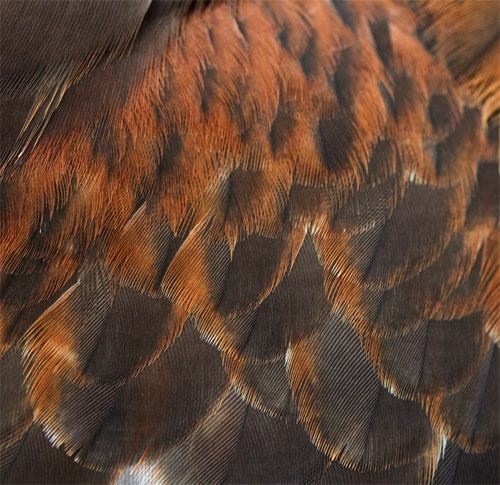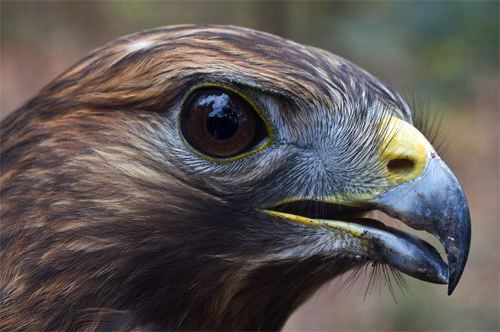|
|
|||
|
(Back to Preceding Week; on to Next Week) |
|
SIGN UP FOR TWO OR MORE EXPEDITIONS AND GET $100 OFF ON EACH Join fellow birders & educators as citizen scientists on 2011 Operation RubyThroat expeditions to observe, capture & band hummingbirds in Belize, Guatemala & Costa Rica. No experience necessary! |
|
RED-SHOULDERED HAWK: For the past month or so we've been watching a Belted Kingfisher pair take advantage of improved fishing opportunities as near-lack of rainfall has caused the Hilton Pond water level to drop progressively lower. Right now we're nearly four feet below optimum. This tends to crowd the fishes a bit--forcing them into shallows where an enterprising kingfisher can swoop in and grab breakfast while barely getting wet. The two kingfishers we're currently hosting are so active we thought we might be able to capture them for banding and photography, especially since they were prone to perching on a wooden bench at the end of a long pier that juts into the pond (below). Because the pier is completely out in the open it's not an ideal site for mist nets we use to capture many kinds of birds, so we did some research that included a query to a banders' listserv, wondering if anyone had been successful using traps to catch kingfishers.
All text & photos © Hilton Pond Center We soon heard from Bill Barnard of Norwich University in Vermont, who suggested putting a mouse or fish in a bal-chatri trap and placing it on the bench where hungry kingfishers might see it. Bill even generously offered to donate a new bal-chatri for our use and shipped it out the same day. (Thanks, Bill!) This trap--a small wire mesh cage covered with monofilament nooses--was invented centuries ago in East India; it's still used there and elsewhere to capture birds of prey for falconry. Due to other obligations we had to put the trap aside when it arrived, but this week at Hilton Pond Center we caught a White-footed Mouse raiding the farmhouse pantry and finally deployed the trap on the pier--securing the contraption to the bench with bungee cords before stepping back into the woods with our camera to wait for a kingfisher to come for the bait. Just a few minutes later a bird swooped in and we bolted for the bal-chatri--not to extract a Belted Kingfisher but to try to corral a mouse-craving Red-shouldered Hawk!
All text & photos © Hilton Pond Center Even as we hustled onto the 60-foot pier and approached the trap, the hawk was so intent on getting its prey it seemed to ignore us; in fact, the bird might not yet have realized it was caught. It wasn't until we got right to the bench that the hawk started flapping (above), at which point we grabbed its thighs with one hand--carefully avoiding the talons--and gently folded its wings down with the other. Amazingly the hawk calmed immediately and in less than a minute we were able to remove monofilament loops from one toe on each foot. Holding tightly enough to secure the bird without causing injury, we covered its head and body with a towel we'd brought for that purpose and walked back toward the banding table in our office.
All text & photos © Hilton Pond Center Several Red-shouldered Hawks we've handled through the years have been downright rambunctious--one flapped so much son Billy III had to help hold it down during the banding process--but this week's capture was quite docile. In fact, aside from a few screeching vocalizations and a couple of MOSTLY ineffective attempts at biting our hands, the red-shoulder was quite cooperative while we handled it and even as we swapped camera lenses with our free hand. Still, we were careful not to loosen our grip on its drumsticks (above), lest the hawk squirm away or dig into us with powerful claws that represent much more danger to a bander than its impressive decurved bill.
All text & photos © Hilton Pond Center For almost the entire 28 years we've been at Hilton Pond Center we've watched Red-shouldered Hawks that nest in the bottomlands below the pond and typically fledge a couple of youngsters each spring. This family of buteos--probably multi-generational--pretty much has had its run of the property for decades and we're glad of it. They keep our population of Eastern Gray Squirrels and Eastern Chipmunks in check and use their sharply hooked bills (above) to decapitate and devour a never-ending supply of wayward mice and voles.
All text & photos © Hilton Pond Center These local Red-shouldered Hawks, Buteo lineatus, often hang around the edges of Hilton Pond, sometimes grabbing a frog or two. One winter we watched as a red-shouldered even managed to beach a 15" Largemouth Bass that had ventured into the shallows. Somehow the hawk secured the fish with its super-sharp inch-long talons (above), wrestled it ashore, and dragged it 60 feet into the woods--where it calmly plucked out an eyeball and consumed a filet before flying away with a full crop.
All text & photos © Hilton Pond Center Despite running quite a few mist nets around the property we seldom actually capture sharp-eyed Red-shouldered Hawks, in part because our 30mm net mesh is too small to regularly snare such big birds (above); a couple of times we've seen a hawk hit a net in full flight and bounce out trampoline-style before fluffing up its feathers and heading off in another direction. Nonetheless, since 1982 we've netted eight red-shoulders, with this week's trapee being our first in-hand since September 2003.
All text & photos © Hilton Pond Center We weren't all that surprised to capture a Red-shouldered Hawk on the pier instead of a Belted Kingfisher; after all, the hawks are almost always on patrol and a moving mouse in a bal-chatri trap was sure to be detected by their sharp eyes.
All text & photos © Hilton Pond Center Eye color is one clue of the age of a Red-shouldered Hawk, but there are other characteristics that, in combination, help give a better indication of the age of a particular individual. Recent fledglings like the one we photographed at Hilton Pond Center this spring (above) have vertical brown streaking on their breasts and look nothing like post-juveniles, whose intense rusty undersides (below) are graced by what we think is one of the most gorgeous hues found among all native North American birds.
All text & photos © Hilton Pond Center The photo just above, taken at the Center in late January 2007, shows a Red-shouldered Hawk with "adult" plumage but a light-colored eye--indicating it hatched in 2006 and was a "second year" bird at time of sighting. Because this week's capture had similar plumage to the above but a much darker eye in mid-November, we lean toward calling it a "third year" individual that would have fledged in 2008.
All text & photos © Hilton Pond Center One other big difference between plumages of juvenile and adult Red-shouldered Hawks occurs in the tail. Young birds have rectrices (tail feathers) with indistinct crossbars (left).
All text & photos © Hilton Pond Center An interesting non-avian aspect of this week's Red-shouldered Hawk capture was obvious from the moment we had our hands on the bird: Crawling around on its back feathers was a half-inch-long hippoboscid fly (above). These so-called "flat flies" have compressed bodies that allow them to squeeze between feather vanes and get to get to a patch of bare skin that is otherwise protected by plumage. As might be expected, hippobiscids are blood-suckers, and different species of birds host different hippoboscid species. The one on the red-shouldered was the largest flat fly we'd ever observed; those on smaller birds are proportionally smaller. What was most curious about the hippoboscid on this week's Red-shouldered Hawk was it stayed in full view for almost the entire time we were handling the bird, only occasionally ducking underneath a back feather. We wonder if the ectoparasite somehow sensed something odd was going on and was preparing to bail out if something happened to its current host.
All text & photos © Hilton Pond Center After photographing the hippoboscid fly we completed our measurements of the hawk--not an easy task because all our tools are for much smaller birds--and then prepared to band it. This was also more tedious than our regular banding procedure because smaller birds we handle regularly take "butt bands" that open easily and can be closed down almost effortlessly with standard banding pliers. However, simple butt bands can't be applied to bigger raptors like Red-shouldered Hawks because they use the sharp tips of their hooked bills to pry off the aluminum ring. To overcome this problem, the federal Bird Banding Laboratory issues "lock-on bands" that have two flanges (above), one longer than the other. After the band is opened and placed on a hawk's leg it closes like a butt band, but then the longer flange is bent over the shorter to "lock" the band. A properly sized lock-on band--in this case a #6--still spins and slides on the exposed tibiotarsus, but the raptor is unable to remove it.
All text & photos © Hilton Pond Center When we examined our temporarily captive Red-shouldered Hawk, we took a close look at all its external attributes. Of particular interest was the cere, a relatively soft and fleshy area at the base of the bill. In young red-shoulders, the cere is greenish (below right) but as the bird matures it turns bright yellow (above). There's lots of speculation about the function(s) of the cere. Some ornithologists believe it helps keep squirmy things out of the hawk's nostrils, while others claim it protects the living, growing base of the bill.
All text & photos © Hilton Pond Center One final field mark of Red-shouldered Hawks that almost needs no mention is, well, its red shoulder (above and below). We point out this character, however, because the rusty region that gives hawk its common name isn't on the shoulder at all but at the outermost bend of the wing; this is really the bird's wrist. (Somehow, "Red-wristed Hawk" doesn't sound quite right.) Although this red patch is visible on fledgling hawks, it--like the rest of a red-shoulder's plumage--doesn't acquire full intensity of color until the bird starts bringing in its "adult" feathers.
All text & photos © Hilton Pond Center So there you have it, our encounter with a mostly unexpected Red-shouldered Hawk captured in a trap set for Belted Kingfishers. We're glad we didn't actually catch a kingfisher, knowing our Hilton Pond hawk might have gone after a snared one as quickly as it did the White-footed Mouse in the bal-chatri. (Note to Self: Find a different way to catch kingfishers for banding.) Incidentally, the mouse survived this whole adventure so we released it back in the woods--well out of sight of our newly banded, still-hungry Red-shouldered Hawk.
All text & photos © Hilton Pond Center If you have a Twitter account and liked this page, you can Follow us on Twitter: @hiltonpond
|



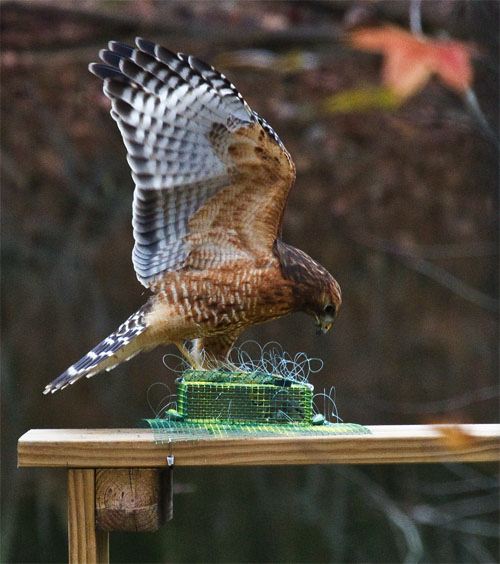

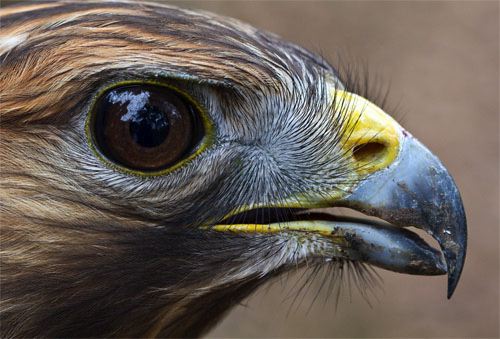
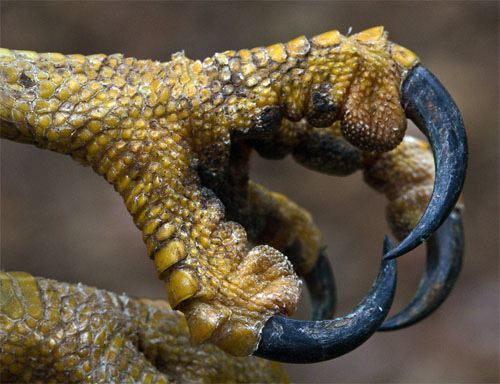


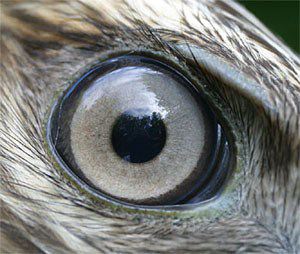 Despite popular belief, birds of prey don't really have "telescopic" vision, but they do have greater acuity, with retinas containing many more rods and cones than in humans. As a result, a hawk or eagle is able to detect smaller movements over greater distances. No matter how they do it, the hawk's eye is a marvel to look at. In young red-shoulders the iris starts out a pale gray (above right); as the bird ages its eye changes to a rich brown (above) and finally to an intense crystal-clear red in most older adults.
Despite popular belief, birds of prey don't really have "telescopic" vision, but they do have greater acuity, with retinas containing many more rods and cones than in humans. As a result, a hawk or eagle is able to detect smaller movements over greater distances. No matter how they do it, the hawk's eye is a marvel to look at. In young red-shoulders the iris starts out a pale gray (above right); as the bird ages its eye changes to a rich brown (above) and finally to an intense crystal-clear red in most older adults.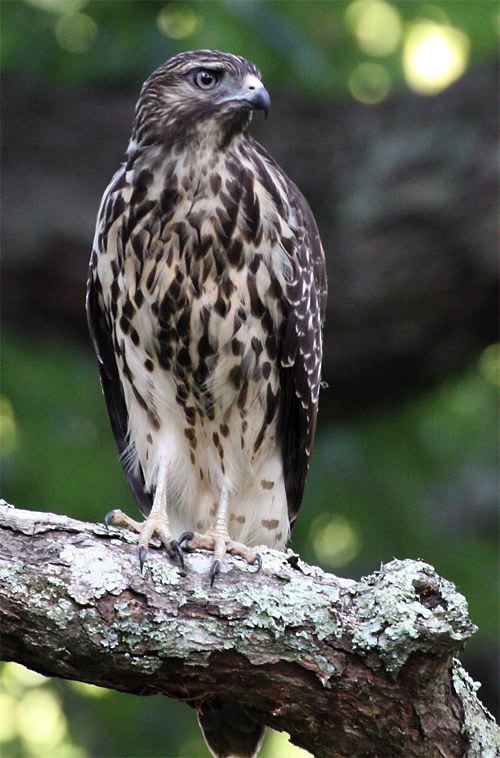
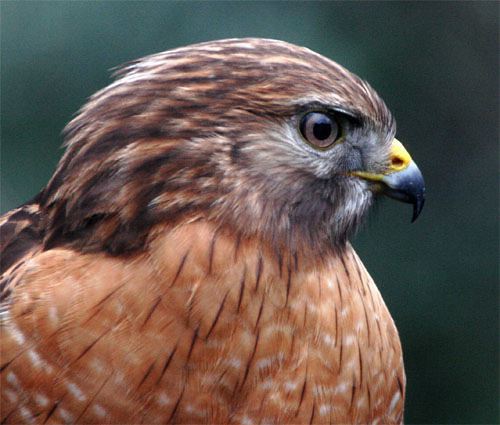

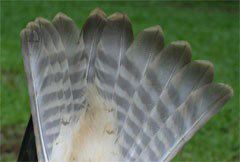 Replacement feathers have white tips and alternating dark and white bands (above) that show nicely when the bird is circling overhead--but not as distinctly as in the photo OR as brightly as in the somewhat smaller Broad-winged Hawk. You'll also notice the red-shoulder's juvenal rectrices are slightly pointed, while those in the adult are more rounded.
Replacement feathers have white tips and alternating dark and white bands (above) that show nicely when the bird is circling overhead--but not as distinctly as in the photo OR as brightly as in the somewhat smaller Broad-winged Hawk. You'll also notice the red-shoulder's juvenal rectrices are slightly pointed, while those in the adult are more rounded.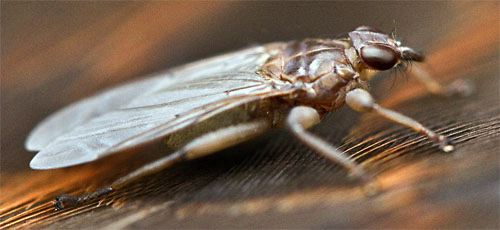
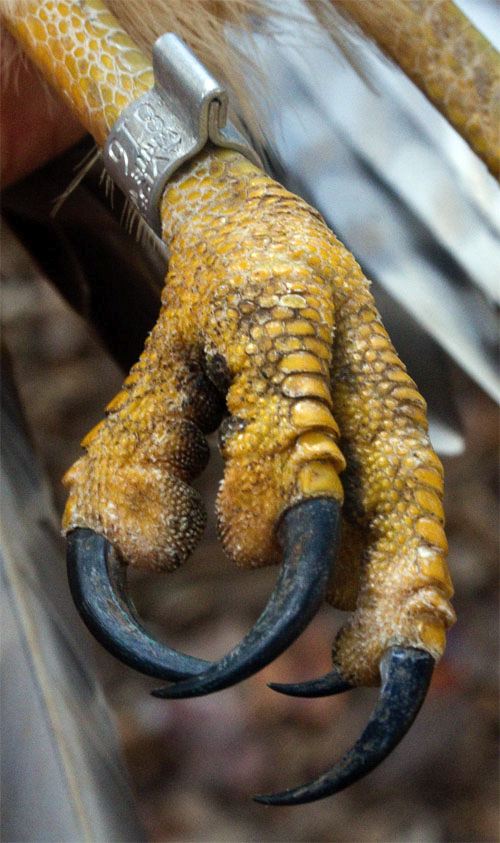
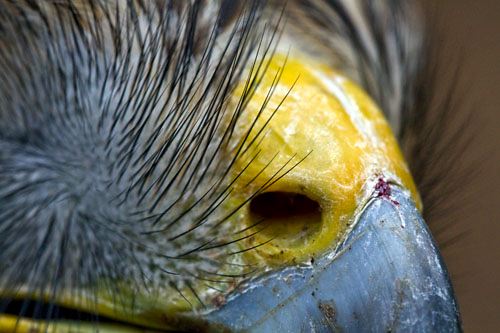
 (Since the structure also occurs in birds such as fruit-eating parrots, we tend to side with the latter explanation.) Also visible in the photo above is a whorl of rictal bristles--highly modified feathers that are quite stiff. Again, the authorities speculate on the function of these structures. Hawks don't seem to use rictal bristles as sensory structures like a cat's whiskers, but being at the base of the bill they may help with hygiene; fluffy feathers would be pretty hard to clean after a hawk gorged on a particularly juicy prey item. Our own conjecture is the bristles help deflect struggling prey from clawing at a hawk's eyes while the predator is administering the killing bite. (Less spectacular bristle arrays are found in numerous other species--including smaller birds in which the structures might keep things like beetle legs from scratching a bird's eyes.)
(Since the structure also occurs in birds such as fruit-eating parrots, we tend to side with the latter explanation.) Also visible in the photo above is a whorl of rictal bristles--highly modified feathers that are quite stiff. Again, the authorities speculate on the function of these structures. Hawks don't seem to use rictal bristles as sensory structures like a cat's whiskers, but being at the base of the bill they may help with hygiene; fluffy feathers would be pretty hard to clean after a hawk gorged on a particularly juicy prey item. Our own conjecture is the bristles help deflect struggling prey from clawing at a hawk's eyes while the predator is administering the killing bite. (Less spectacular bristle arrays are found in numerous other species--including smaller birds in which the structures might keep things like beetle legs from scratching a bird's eyes.) 
